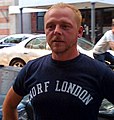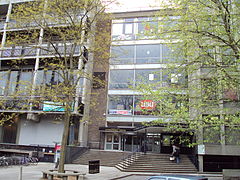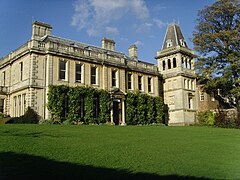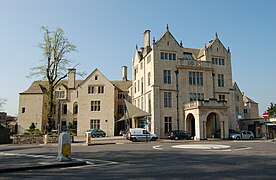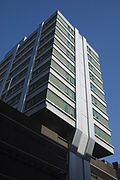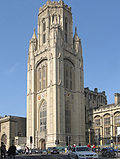University of Bristol
 From Wikipedia - Reading time: 41 min
From Wikipedia - Reading time: 41 min
 | |
| Motto | Latin: Vim promovet insitam |
|---|---|
Motto in English | [Learning] promotes one's innate power (from Horace, Ode 4.4)[1] |
| Type | Public red brick research university |
| Established | 1595 – Merchant Venturers School 1876 – University College, Bristol 1909 – received royal charter |
| Endowment | £86.1 million (2023)[2] |
| Budget | £902.2 million (2022/23)[2] |
| Chancellor | Sir Paul Nurse[3] |
| Vice-Chancellor | Evelyn Welch |
| Visitor | Rt Hon. Lucy Powell MP (as Lord President of the Council ex officio) [4] |
Academic staff | 3,675 (2022/23)[5] |
Administrative staff | 5,010 (2022/23)[5] |
| Students | 32,100 (2022/23)[6] |
| Undergraduates | 23,470 (2022/23)[6] |
| Postgraduates | 8,635 (2022/23)[6] |
| Location | , England 51°27′23″N 02°36′16″W / 51.45639°N 2.60444°W |
| Campus | Urban |
| Students' Union | University of Bristol Union |
| Colours | Pantone 187[7] |
| Affiliations | |
| Website | bristol |
 | |
The University of Bristol is a red brick Russell Group research university in Bristol, England.[8] It received its royal charter in 1909,[9] although it can trace its roots to a Merchant Venturers' school founded in 1595 and University College, Bristol, which had been in existence since 1876.[10] Bristol Medical School, founded in 1833, was merged with the University College in 1893, and later became the university's school of medicine.[11]
The university is organised into six academic faculties composed of multiple schools and departments running over 200 undergraduate courses, largely in the Tyndalls Park area of the city.[12] It had a total income of £902.2 million in 2022–23, of which £203.3 million was from research grants and contracts.[2] It is the largest independent employer in Bristol.[13] Current academics include 23 fellows of the Academy of Medical Sciences, 13 fellows of the British Academy, 43 fellows of the Academy of Social Sciences,[14] 13 fellows of the Royal Academy of Engineering and 48 fellows of the Royal Society.[15] The University of Bristol's alumni and faculty include 13 Nobel laureates.[16]
Bristol is a member of the Russell Group of research-intensive British universities,[17] the European-wide Coimbra Group[18] and the Worldwide Universities Network, of which the university's previous vice-chancellor, Eric Thomas, was chairman from 2005 to 2007.[19] In addition, the university holds an Erasmus Charter, sending more than 500 students per year to partner institutions in Europe.[20] It has an average of 6.4 (Sciences faculty) to 13.1 (Medicine & Dentistry Faculty) applicants for each undergraduate place.[21]
History
[edit]Foundation
[edit]The earliest antecedent of the university was the engineering department of the Merchant Venturers' Technical College (founded as a school as early as 1595) which became the engineering faculty of Bristol University.[22] The university was also preceded by Bristol Medical School (1833) and University College, Bristol, founded in 1876,[10] where its first lecture was attended by only 99 students.[23] The university was able to apply for a royal charter due to the financial support of the Wills and Fry families, who made their fortunes in tobacco plantations and chocolate respectively (while there was no funding from Edward Colston).[24] A 2018 study commissioned by the university estimated 85% of the philanthropic funds used for the institution's foundation "depended on the labour of enslaved people".[25]
The royal charter was gained in May 1909, with 288 undergraduates and 400 other students entering the university in October 1909. Henry Overton Wills III became its first chancellor.[10] The University College was the first such institution in the country to admit women on the same basis as men.[10] However, women were forbidden to take examinations in medicine until 1906.[26]
Historical development
[edit]|
There shall be from henceforth for ever in Our said City of Bristol a University... |
| King Edward VII, Charter of Incorporation of the University of Bristol, 4 December 1909[27] |
Since the founding of the university itself in 1909, it has grown considerably and is now one of the largest employers in the local area, although it is smaller by student numbers than the nearby University of the West of England.[28] It is a member of the Russell Group of research-led UK universities, the Coimbra Group of leading European universities and the Worldwide Universities Network (WUN).
Early years
[edit]
After the founding of the university college in 1876, government support began in 1889. Funding from mergers with the Bristol Medical School in 1893 and the Merchant Venturers' Technical College in 1909,[30] allowed the opening of a new medical school and an engineering school — two subjects that remain among the university's greatest strengths. In 1908, gifts from the Fry and Wills families, particularly £100,000 from Henry Overton Wills III (£6m in today's money), were provided to endow a university for Bristol and the West of England, provided that a royal charter could be obtained within two years. In December 1909, the king granted such a charter and erected the University of Bristol.[27] Henry Wills became its first chancellor and Conwy Lloyd Morgan the first vice-chancellor.[31] Wills died in 1911 and in tribute his sons George and Harry built the Wills Memorial Building, starting in 1913 and finally finishing in 1925.[32] Today, it houses parts of the academic provision for earth sciences and law, and graduation ceremonies are held in its Great Hall. The Wills Memorial Building is a Grade II* listed building.[33]
In 1920, George Wills bought the Victoria Rooms and endowed them to the university as a students' union.[10] The building now houses the Department of Music and is a Grade II* listed building.[34]
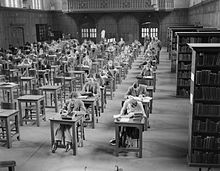
At the point of foundation, the university was required to provide for the local community. This mission was behind the creation of the Department of Extra-Mural Adult Education in 1924 to provide courses to the local community. This mission continues today; a new admissions policy specifically caters to the "BS" postcode area of Bristol.[35]
Among the famous names associated with Bristol in this early period is Paul Dirac, who graduated in 1921 with a degree in engineering, before obtaining a second degree in mathematics in 1923 from Cambridge. For his subsequent pioneering work on quantum mechanics, he was awarded the 1933 Nobel Prize in Physics.[36] Later in the 1920s, the H.H. Wills Physics Laboratory was opened by Ernest Rutherford.[37] It has since housed several Nobel Prize winners: Cecil Frank Powell (1950);[38] Hans Albrecht Bethe (1967);[39] and Sir Nevill Francis Mott (1977).[40] The laboratory stands on the same site today, close to the Bristol Grammar School and the city museum.
Sir Winston Churchill became the university's third chancellor in 1929, serving the university in that capacity until 1965.[10] He succeeded Richard Haldane who had held the office from 1912 following the death of Henry Wills.[26][31]
During World War II, the Wills Memorial was bombed, destroying the Great Hall and the organ it housed,[10] along with 7,000 books removed from King's College London for safe keeping. It has since been restored, complete with oak panelled walls and a new organ.
Post-war development
[edit]In 1946, the university established the first drama department in the country.[10] In the same year, Bristol began offering special entrance exams and grants to aid the resettlement of servicemen returning home. Student numbers continued to increase, and the Faculty of Engineering eventually needed the new premises that were to become Queen's Building in 1955. This substantial building housed all of the university's engineers until 1996, when the electrical engineering and computer science departments moved over the road into the new Merchant Venturers' Building to make space for these rapidly expanding fields. Today, Queen's Building caters for most of the teaching needs of the faculty and provides academic space for the "heavy" engineering subjects (civil, mechanical, and aerospace).
With unprecedented growth in the 1960s, particularly in undergraduate numbers, the Students' Union eventually acquired larger premises in a new building in the Clifton area of the city, in 1965. This building was more spacious than the Victoria Rooms, which were now given over to the Department of Music. The University of Bristol Union provides many practice and performance rooms, some specialist rooms, as well as three bars: Bar 100, the Mandela (also known as AR2) and the Avon Gorge. Whilst spacious, the Union building is thought by many to be ugly[41] and out of character compared to the architecture of the rest of the Clifton area, having been mentioned in a BBC poll to find the worst architectural eyesores in Britain.[42] The university has proposed relocating the Union to a more central location as part of its development 'masterplan'.[43] More recently, plans for redevelopment of the current building have been proposed.[44]
The 1960s were a time of considerable student activism in the United Kingdom, and Bristol was no exception. In 1968, many students marched in support of the Anderson Report, which called for higher student grants. This discontent culminated in an 11-day sit-in at the Senate House (the administrative headquarters of the university).[10] A series of chancellors and vice-chancellors led the university through these decades, with Henry Somerset, 10th Duke of Beaufort taking over from Churchill as chancellor in 1965 before being succeeded by Dorothy Hodgkin in 1970 who spent the next 18 years in the office.[31]
As the age of mass higher education dawned, Bristol continued to build its student numbers. The various undergraduate residences were repeatedly expanded and, more recently, some postgraduate residences have been constructed. These more recent ventures have been funded (and are run) by external companies in agreement with the university.
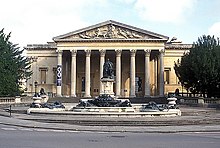
One of the few centres for deaf studies in the United Kingdom was established in Bristol in 1981, followed in 1988 by the Norah Fry Centre for research into learning difficulties. Also in 1988, and again in 2004,[45] the Students' Union AGM voted to disaffiliate from the National Union of Students (NUS). On both occasions, however, the subsequent referendum of all students reversed that decision and Bristol remains affiliated to the NUS.
In 1988, Sir Jeremy Morse, then chairman of Lloyds Bank, became chancellor.
21st century
[edit]As the number of postgraduate students has grown (particularly the numbers pursuing taught master's degrees), there eventually became a need for separate representation on university bodies and the Postgraduate Union (PGU) was established in 2000.[46] Universities are increasingly expected to exploit the intellectual property generated by their research activities and, in 2000, Bristol established the Research and Enterprise Division (RED) to further this cause (particularly for technology-based businesses). In 2001, the university signed a 25-year research funding deal with IP2IPO, an intellectual property commercialisation company.[47] In 2007, research activities were expanded further with the opening of the Advanced Composites Centre for Innovation and Science (ACCIS) and The Bristol Institute for Public Affairs (BIPA).
In 2002, the university was involved in an argument over press intrusion after details of then-prime minister Tony Blair's son's application to university were published in national newspapers. In the same year, the university opened the new Centre for Sports, Exercise and Health in the heart of the university precinct.[48] At a cost, local residents are also able to use the facilities.[49]
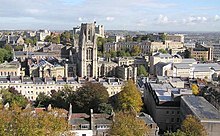
Brenda Hale, the first female Law Lord, became chancellor of the university in 2003.[26][31] Sir Paul Nurse succeeded Lady Hale as chancellor on 1 January 2017.
Expansion of teaching and research activities continues. In 2004, the Faculty of Engineering completed work on the Bristol Laboratory for Advanced Dynamics Engineering (BLADE). This £18.5m project[50] is intended to further the study of dynamics and is the most advanced such facility in Europe.[51] It was built as an extension to the Queen's Building and was officially opened by Queen Elizabeth II in March 2005.
In January 2005, the School of Chemistry was awarded £4.5m by the Higher Education Funding Council for England to create Bristol ChemLabS: a Centre for Excellence in Teaching & Learning (CETL),[52] with an additional £350k announced for the capital part of the project in February 2006. Bristol ChemLabS stands for Bristol Chemical Laboratory Sciences; it is the only chemistry CETL in the UK.
September 2009 saw the opening of the university's Centre for Nanoscience and Quantum Information. This £11 million building is known as the quietest building in the world[clarification needed] and has other technologically sophisticated features such as self-cleaning glass. Advanced research into quantum computing, nanotechnology, materials and other disciplines are being undertaken in the building.[53]
There is also a plan to significantly redevelop the centre of the University Precinct in the coming years.[54] The first step began in September 2011, with the start of construction of a state-of-the-art Life Sciences building.[55]
In 2018 while building work was underway in the Fry Building,[56][57] the building caught fire.[58][59]
In 2018 the University of Bristol Students' Union (Bristol SU) adopted a motion that banned trans-exclusionary radical feminists (TERFs) from appearing as speakers at Bristol SU events and that called upon the university to adopt the same policy. The motion said the TERF ban was necessary because TERF activity on the university campus "put[s] trans students' safety at risk ... in direct violation of the aims outlined in the Code of Conduct".[60][61][62][63]
On 19 March 2019, the University received a complaint regarding a lecture about Islamophobia given by Professor of Political Sociology David Miller, made by the Community Security Trust, a third-party. Soon after, further complaints were made by two students, who had not attended the lecture. A long and very complex complaints, appeals, two barrister investigations, a university Board of Trustees decision, and disciplinary hearing process followed.[64] Ultimately this led to Miller's dismissal in October 2021.[65] Miller pursued an employment tribunal claim. On 5 February 2024, in an 108 page judgement the tribunal ruled in favour of Miller, based in part on a landmark ruling that "anti-Zionist beliefs qualified as a philosophical belief and as a protected characteristic pursuant to section 10 Equality Act 2010".[66][64]
In 2021, Raquel Rosario-Sánchez, a Dominican graduate student at Bristol who had attended meetings of feminist groups that opposed allowing trans women into female-only spaces, filed a civil action against Bristol University;[67] Rosario-Sánchez alleges that she was the victim of a campaign of bullying and abuse against her by other members of the university, and that the university failed to protect her because it was afraid of upsetting trans-rights activists.[68][67][69] The case went to trial in February 2022.[70][71] The judgment was delivered in April 2022. The judge acknowledged that she had been subject to threats of violence, but dismissed all her claims, saying that there had been no actionable breach of duty by the university. He said that his ruling focused on how the university managed her complaints rather than any judgment about gender rights.[72][73] In February 2023, following its previous disciplinary action against Rosario-Sánchez and the Women Talk Back group, it emerged that the Bristol Students Union has agreed out-of-court that "affiliated clubs and societies may lawfully offer single-sex services and be constituted as single-sex associations".[74]
In 2024 the university revised their emblem, removing the dolphin emblem because of its connection to the slave-trader Edward Colston and adding an image of moving pages and a bookmark.[75]
Campus
[edit]
Buildings and sites
[edit]The university does not have a main campus but is spread over a considerable geographic area. Most of its activities, however, are concentrated in the area of the city centre, referred to as the "University Precinct".
Some of the University of Bristol's buildings date to its pre-charter days when it was University College Bristol. These buildings were designed by Charles Hansom, and suffered being built in stages due to financial pressure. The first large scale building project the University of Bristol undertook on gaining a charter was the Wills Memorial Building. The armorials on the Founder's Window represent all of the interests present at the founding of the University of Bristol including the Wills and Fry families. Other notable buildings and sites include Royal Fort House, the University of Bristol Botanic Garden, many large Victorian houses which were converted for teaching in the Faculty of Arts,[76] and the Victoria Rooms which house the Music Department and were designed by Charles Dyer. The tympanum of the building depicts a scene from The Advent of Morning designed by Jabez Tyley.[77]
Goldney gardens entered the property of the University of Bristol through George Wills who had hoped to build an all-male hall of residence there. This was prevented due to the moral objection of the then warden of Clifton Hill House who objected to the idea of male and female residences being in such close proximity. University records show that Miss Starvey was prepared to resign over the issue and that she had the support of the then Chancellor Conwy Lloyd Morgan.[78] Eventually land was purchased in Stoke Bishop, allowing the building of what has been described as a "quasi-Oxbridge" hall, Wills Hall, to which was added the Dame Monica Wills Chapel by George Wills' widow after his death. When Goldney did become student accommodation in 1956, the flats were designed by Michael Grice who received an award from the Civic Trust for their design.[79]
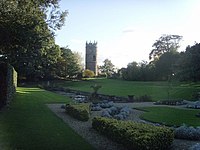
Burwalls, a mansion house on the other side of the Avon Gorge, was used as a halls of residence in the past and was a home of Sir George Oatley. The building is now used to house the Centre for Continuing Education.[80]
Many of the more modern buildings, including Senate House and the newer parts of the HH Wills Physics Laboratory, were designed by Ralph Brentnall using funds from the University Grants Committee. He is also responsible for the extension to the Wills Memorial Building library which was completed to such standard that few now realise that is an extension to the original building.[81]
In May 2022, the university announced the opening of the Gambling Harms and Research Centre (GHRC). The centre worth £4 million aims to increase awareness and understanding of the dangers of gambling. The project was funded by the GambleAware charity, which chose the university for its history in researching gambling issues, and will integrate research from six facilities.[82]
Planned expansion
[edit]In November 2016, the university announced that it plans to build a £300 million Temple Quarter Campus for c. 5,000 students, next to Bristol Temple Meads railway station within Bristol Temple Quarter Enterprise Zone. The new campus, which will include a business school, digital research facilities and a student village, is expected to open in 2021.[83] For the existing campus, there are plans to remodel Tyndall Avenue, pedestrianise the surrounding area and build a new library and resource hub.[84]
Organisation and governance
[edit]In common with most UK universities, Bristol is headed formally by the chancellor, currently Sir Paul Nurse and led on a day-to-day basis by the vice-chancellor, currently Professor Evelyn Welch, who is the academic leader and chief executive. There are four pro vice-chancellors and three ceremonial pro-chancellors.[85] The chancellor may hold office for up to ten years and the pro-chancellors for up to three, unless the University Court determines otherwise,[86][87] but the vice-chancellor and pro-vice-chancellors have no term limits.[88][89] The vice-chancellor is supported by a deputy vice-chancellor.
Responsibility for running the university is held at an executive level by the vice-chancellor, but the council is the only body that can recommend changes to the university's statutes and charter,[90] with the exception of academic ordinances. These can only be made with the consent of the senate, the chief academic body in the university which also holds responsibility for teaching and learning, examinations and research and enterprise.[90][91] The chancellor and pro chancellors are nominated by council and appointed formally by court, whose additional powers are now limited to these appointments and a few others, including some lay members of council.[92] Finally, Convocation, the body of all staff, ceremonial officers and graduates of the university, returns 100 members to court and one member to council,[85] but is otherwise principally a forum for discussion and to ensure graduates stay in touch with the university.
The university is made up of a number of schools and departments organised into six faculties:[93]

Faculty of Arts
[edit]- School of Arts
- Anthropology and Archaeology
- Film and Television
- Music
- Philosophy
- Theatre (see also the University of Bristol Theatre Collection)
- School of Humanities
- Classics and Ancient History
- English
- History
- History of Art
- Religion and Theology
- School of Modern Languages
- French
- German
- Hispanic, Portuguese and Latin American Studies
- Italian
- Russian
- Centre for English Language and Foundation Studies
- Centre for Innovation
Faculty of Engineering
[edit]- School of Computer Science, Electrical and Electronic Engineering, and Engineering Mathematics
- Computer Science
- Electrical & Electronic Engineering
- Engineering Mathematics
- School of Civil, Aerospace and Mechanical Engineering
- Aerospace Engineering
- Civil Engineering
- Mechanical Engineering
- Engineering Design
- Engineering with Management

Faculty of Life Sciences
[edit]- School of Biological Sciences
- School of Biochemistry
- School of Cellular and Molecular Medicine
- School of Physiology, Pharmacology and Neuroscience
- School of Psychological Science
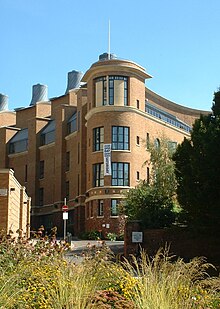
Faculty of Science
[edit]- School of Chemistry
- School of Earth Sciences
- School of Geographical Sciences
- School of Mathematics
- School of Physics
- Centre for Device Thermography and Reliability
- Centre for Nanoscience & Quantum Information
- Interface Analysis Centre
Faculty of Health Sciences
[edit]- Bristol Dental School
- Bristol Medical School
- Population Health Sciences
- Public Health
- Digital Health
- Translational Health Sciences
- Population Health Sciences
- Bristol Veterinary School
- Centre for Health Sciences Education
- Centre for Applied Anatomy
- Master's in Teaching and Learning for Health Professionals
Faculty of Social Sciences and Law
[edit]- School of Education
- School for Policy Studies
- School of Economics
- Centre for Market and Public Organisation
- School of Sociology, Politics and International Studies
- University of Bristol Business School
- University of Bristol Law School
Academic dress
[edit]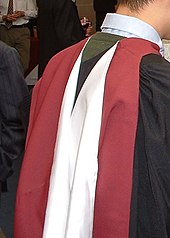
The university specifies a mix of Cambridge and Oxford academic dress. For the most part, it uses Oxford-style gowns and Cambridge-style hoods, which are required to be 'university red'[94] (see the logo at the top of the page).
Logo and arms
[edit]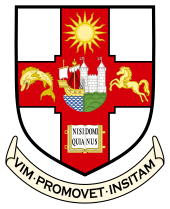
In 2004, the university unveiled its new logo. The icons in the logo are the sun for the Wills family, the dolphin for Colston, the horse for Fry and the ship-and-castle from the medieval seal of the City of Bristol, as also used in the coat of arms. The shape of the whole logo represents the open book of learning.[7] This logo has replaced the university arms shown, but the arms continue to be used where there is a specific historical or ceremonial requirement. The arms comprise:
argent on a cross quadrate gules the arms of the City of Bristol between in pale and a sun in splendour (for Wills) and an open book proper, leaved and clasped or, and inscribed with the words Nisi quia Dominus, and in fesse to the sinister a dolphin embowed (for Colston), and to the dexter a horse courant (for Fry), both of the third.
The inscription on the book is the Latin opening of the 124th Psalm, "If the Lord Himself had not (been on our side...)".[1] The latin motto granted with the Arms below the shields is Vim promovet insitam, from the fourth Ode of Horace's fourth book meaning '[Learning] promotes one's innate power'.[95]
Academics
[edit]Admissions
[edit]
|
| Domicile[99] and Ethnicity[100] | Total | ||
|---|---|---|---|
| British White | 57% | ||
| British Ethnic Minorities[a] | 14% | ||
| International EU | 4% | ||
| International Non-EU | 25% | ||
| Undergraduate Widening Participation Indicators[101][102] | |||
| Female | 54% | ||
| Private School | 27% | ||
| Low Participation Areas[b] | 7% | ||
Bristol had the 8th highest average entry qualification for undergraduates of any UK university in 2015, with new students averaging 485 UCAS points,[103] equivalent to just above AAAaa in A-level grades. Competition for places is high with an average 7.7 applications per place according to the 2014 Sunday Times League Tables, making it the joint 11th most competitive university in the UK.[104] The university gave offers of admission to 52.2% of its undergraduate applicants in 2022, the 17th lowest offer rate across the country.[105]
According to the 2017 Times and Sunday Times Good University Guide, approximately 40% of Bristol's undergraduates come from independent schools.[106] In the 2016–17 academic year, the university had a domicile breakdown of 78:5:17 of UK:EU:non-EU students respectively with a female to male ratio of 55:45.[107]
Rankings and reputation
[edit]| National rankings | |
|---|---|
| Complete (2025)[108] | 16 |
| Guardian (2025)[109] | 16 |
| Times / Sunday Times (2025)[110] | 11 |
| Global rankings | |
| ARWU (2024)[111] | 97 |
| QS (2025)[112] | 54 |
| THE (2025)[113] | 78 |
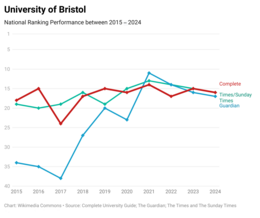
The University of Bristol ranks number 5 in the UK for research quality according to the most recent Research Excellence Framework assessment.[114] Chemistry (1st), Physics (5th), Engineering (6th), Mathematical sciences (4th), Computer science and informatics (7th), Earth systems and environmental sciences (2nd), Biological sciences (8th), Geography and environmental studies (1st), Law (3rd), Economics and econometrics (7th), and Modern languages and linguistics (4th) are among the highly rated subjects.[115][116][117][118][119][120][121][122][123][124][125] The Complete University Guide 2024 ranks Bristol 4th for the quality of its research.[126] Bristol also ranks 5th for number of spin outs created and has the best business incubator in the world according to UBI Global.[127][128]
The University of Bristol was the fourth most targeted university by the UK's top 100 employers, according to the Graduate Market in 2023 report produced by High Fliers.[129] It was ranked joint 7th in the U.K. for graduate employability.[130]
Internationally, the 2024 QS World University Rankings placed Bristol at 55th overall in the world and 9th in the UK.[131] The Times Higher Education World University Ranking placed Bristol at 76th globally and 9th in the U.K. in 2023.[132] Another international ranking, the Shanghai Jiao Tong University Academic Ranking of World Universities, placed Bristol 88th globally and 8th in the UK in 2023.[133]

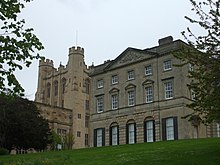
Degrees
[edit]Bristol awards a range of academic degrees spanning bachelor's and master's degrees as well as junior doctorates and higher doctorates. The postnominals awarded are the degree abbreviations used commonly among British universities. The university is part of the Engineering Doctorate scheme,[134] and awards the Eng. D. in systems engineering, engineering management, aerospace engineering and non-destructive evaluation.[135]
Bristol notably does not award by title any bachelor's degrees in music, which is available for study but awarded BA (although it does award MMus and DMus), nor any degree in divinity, since divinity is not available for study (students of theology are awarded a BA). Similarly, the university does not award BLitt (Bachelor of Letters), although it does award both MLitt and DLitt. In regulations, the university does not name MD or DDS as higher doctorates, although they are in many universities[136] as these degrees are normally accredited professional doctorates.
The degrees of DLitt, DSc, DEng, LLD and DMus, whilst having regulations specifying the grounds for award,[137] are most often conferred as honorary degrees (in honoris causa).[138] Those used most commonly are the DLitt, DSc and LLD, with the MA (and occasionally the MLitt) also sometimes conferred honorarily for distinction in the local area or within the university.
Publishing and commercial activities
[edit]University of Bristol has various activities including publication, joint ventures, and catering and accommodation services.
Bristol University Press
[edit]Bristol University Press is scholarly press based at University of Bristol.[139] In 1996, the University of Bristol established Policy Press, an academic publisher based in the Faculty of Social Sciences and Law at the University of Bristol and specialising in the social sciences. In October 2016, Policy Press became an imprint of newly founded Bristol University Press.[140][141]
It is not-for-profit university press which publishes 15 journals and 200 books a year in subjects including: Ageing and Gerontology, Business and Management, Criminology, Economics and Society, Environment and Sustainability, International Development, Law, Politics and International Relations, Science, Technology and Society, and Sociology. It achieved journal citation metrics with gains in Journal Impact Factors and improved results in Journal Citation Indicator, Scopus CiteScore and SJR.[142]
Bristol is Open
[edit]Bristol is Open, abbreviated as BiO, is a joint venture project between Bristol City Council and University of Bristol. It is for delivering research contributing to the development of a Smart City and deploying a city-scale open and programmable testbed for experimentation and digital innovation.[143] The collaboration of two organisations started in April 2015 and ended in December 2019 with Bristol City Council taking full control of BiO's operations.[144] It has completed many technical trials and experiments including open access to Wi-Fi as a reduction of the digital divide and development for Smart City technology.
Student life
[edit]Students' Union
[edit]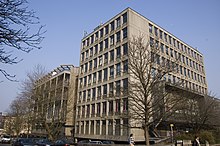
The University of Bristol Students' Union (Bristol SU) located on Queen's Road in the Richmond Building is a founding member of the National Union of Students and is amongst the oldest students' unions in England. The union oversees three media outlets: UBTV, the Bristol University Radio Station (BURST) and the student newspaper Epigram. There is also a local branch of The Tab.[145] The Union is responsible for representing students' academic interests through elections of student representatives and democratic events. The Union is also responsible for the organisation of the annual Welcome Fair, the co-ordination of Bristol Student Community Action, which organises volunteering projects in the local community, and the organisation of entertainment events and over 400[146] student groups, societies and clubs. Previous presidents have included Sue Lawley and former Liberal Democrat MP Lembit Öpik. There is a separate union for postgraduate students, as well as an athletic union, which is a member of the British Universities & Colleges Sport.[147] In distinction to the "blues" awarded for sporting excellence at Oxford and Cambridge, Bristol's most successful athletes are awarded "reds".[148]
Halls of residence
[edit]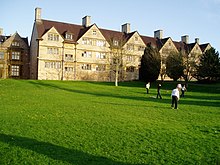
Accommodation for students is primarily in the central precinct of the university and two areas of Bristol: Clifton and Stoke Bishop, known respectively as the West and North Villages.[149]
In Stoke Bishop, Wills Hall on the edge of the Clifton Downs was the first to be opened, in 1929, by the then chancellor, Winston Churchill. Its original quadrangle layout has been expanded twice, in 1962 and 1990.[149] Churchill Hall, named for the chancellor, followed in 1956, then Badock Hall in 1964.[149][150] At the time of Badock Hall's establishment, some of the buildings were called Hiatt Baker Hall, but two years later, Hiatt Baker moved to its own site and is now the largest hall in the university.[149][151] The first self-catering hall in Stoke Bishop was University Hall, established in 1971 with expansion in 1992.[149]
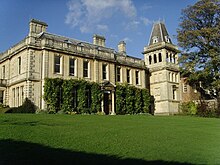
In Clifton, Goldney Hall was built first in the early 18th century by the wealthy merchant Goldney family and eventually became part of the university in 1956.[152] It is a popular location for filming, with The Chronicles of Narnia, The House of Eliott and Truly, Madly, Deeply, as well as episodes of Only Fools and Horses and Casualty, being filmed there.[153] The Grotto in the grounds is a Grade I listed building.[154] Clifton Hill House is another Grade I listed building now used as student accommodation in Clifton. The original building was constructed between 1745 and 1750 by Isaac Ware, and has been used by the university since its earliest days in 1909.[149][155] Manor Hall comprises five separate buildings, the principal of which was erected from 1927 to 1932 to the design of George Oatley following a donation from Henry Herbert Wills. Manor Hall houses the largest and most dated rooms, some dating back to the early 20th century.[156] One of its annexes, Manor House, has recently been refurbished and officially 'reopened' in 1999.[149][157]


On the central precinct sits The Hawthorns, a student house accommodating 115 undergraduate students.[158] The house started life as a collection of villas built somewhere between 1888 and 1924[159] that were later converted, bit by bit, into a hotel by John Dingle.[160] The Hawthorns also houses conferencing facilities, the staff refectory and bar, the Accommodation Office and the Student Houses Office. 33 Colston Street was opened in the city centre in October 2011 after the university acquired the property in 2009.[149]
Several of the residences in the central precinct are more recent and have been built and are managed by third-party organisations under exclusivity arrangements with the university. New Bridewell House, opened in 2016, is in the former police HQ, and is operated by Fresh Student Housing. Unite House and Chantry Court, were opened in 2000 and 2003 respectively by the UNITE Group.[161][162][163] Dean's Court (2001, postgraduates only) and Woodland Court (2005), are both run by the Dominion Housing Group.[164][165]
All of the main halls elect groups of students to the Junior Common Room to organise the halls social calendar for the next year. Residents of student houses, private accommodation and students living at home become members of Orbital – a society organising social events for students throughout the year.[149]
Sport
[edit]This article contains promotional content. (July 2023) |
Sports membership at Bristol University totals up to 4,000 students across a wide range of unique team and individual pursuits. Its network of over 70 sports clubs and four sites are run by the university's Student Union and its Sport,Exercise and Health Department.[166] Competing with other universities in the British Universities and Colleges Sport league (BUCS), Bristol university is placed 8th in the country.
The university caters to its students with sporting facilities split across four primary complexes:
Bristol University Indoor Sports Centre- The Indoor Sports Centre is located at the heart of the university campus and is home to a fully equipped two-storey gym, fitness studios, sports hall and Sports Medicine Clinic. [167]
Coombe Dingle Sports Complex- This 38-acre site in the heart of Stoke Bishop, features the only indoor tennis centre in Bristol and is where the university's more traditional outdoor sports reside. Coombe Dingle is typically used for training and competition. Throughout the year Coombe Dingle hosts a variety of competitive fixtures, including inter-university BUCS matches, plus local and national league matches.:[168]
Facilities available at Coombe Dingle Sports Complex: • 3G pitch • Artificial pitches (sand dressed and floodlit) • Grass pitches (football and rugby) • Cricket squares and nets (including grass) • Tennis courts, indoor and outdoor (floodlit) • Lacrosse pitch • Netball courts (outdoor) • Olympic weight lifting gym • Softball and rounders facilities • Pavilion, lounge bar and meeting rooms • Sports Medicine Clinic
Richmond Building- The university swimming pool is located inside the student union (Richmond Building). This six-lane swimming pool has a moveable bulkhead, creating a competition-length main pool, alongside a comfortable teaching pool for lessons. The pool is available to students, staff and the community for lane and casual swimming, or lessons, on a membership or pay-as-you-go basis. [169]
Saltford Boathouse- The University Boathouse is based at Saltford, halfway to Bath on the River Avon. Used for term-time training/competition and out-of-term recreational water sport, the Boathouse moors up the universities rowing and sailing boats.
Notable people
[edit]Academics
[edit]Current academics at the University of Bristol include 23 fellows of the Academy of Medical Sciences, 13 fellows of the British Academy, 13 fellows of the Royal Academy of Engineering, 43 fellows of the Academy of Social Sciences[14] and 48 fellows of the Royal Society.[170] These include, Sir Michael Berry, one of the discoverers of quantum mechanics' "geometric phase",[171] John Rarity international expert on quantum optics, quantum cryptography and quantum communication, David May, computer scientist and lead architect for the transputer,[172] Mark Horton, a British maritime and historical archaeologist and Bruce Hood, a world-leading experimental psychologist.
Academics in computer science include, David Cliff, inventor of the seminal "ZIP" trading algorithm, Peter Flach, Mike Fraser, professor of human-computer interaction, Julian Gough and Nigel Smart. Academics in engineering include the materials scientist Stephen Eichhorn.
Past academics of the university include, Patricia Broadfoot, vice-chancellor of the University of Gloucestershire, Nigel Thrift, vice-chancellor of the University of Warwick, and Wendy Larner, provost of Victoria University of Wellington.[173][174] Anthony Epstein, co-discoverer of the Epstein-Barr virus, was Professor of Pathology at the university from 1968 to 1982,[175] Sir John Lennard-Jones, discoverer of the Lennard-Jones potential in physics[176][177] and Alfred Marshall, one of the University College's principals and influential economist in the latter part of the 19th century.[178] Mathematicians and philosophers Rohit Parikh and Brian Rotman lectured in the mathematics department, and philosophers of science Paul Feyerabend and Alexander Bird taught in the department of philosophy. Another notable current academic in the department of philosophy includes Havi Carel. Notable mathematicians who have worked in the department of mathematics include Hannes Leitgeb, Philip Welch, Ben Green, Andrew Booker, Julia Wolf, Jens Marklof, John McNamara, Howell Peregrine, Christopher Budd John Hogan, Jeremy Rickard, Richard Jozsa, Corinna Ulcigrai, David Evans and the statistician Harvey Goldstein.
The University of Bristol is associated with three Ig Nobel Prizes, an award for unusual or trivial achievements in scientific research. Sir Michael Berry shared the award (with Andre Geim, a Nobel Laureate) for using magnets to levitate a frog.[179] Gareth Jones also shared an Ig Nobel prize for scientifically documenting fellatio in fruit bats.[180] Dr. Len Fisher was awarded the 1999 prize for physics for calculating the optimal way to dunk a biscuit.[181]
Alumni
[edit]- Notable Bristol alumni include:
-
James Blunt, musician
-
Paul Dirac, physicist
-
Jonathan Evans, former head of MI5
-
Hun Manet, Prime Minister of Cambodia
-
Simon Pegg, actor and writer
-
Susanna Reid, TV journalist
-
David Walliams, comedian
Bristol alumnus Paul Dirac went on to win the Nobel Prize in Physics in 1933 for his contribution to the formulation of quantum mechanics and is considered one of the most significant physicists of the 20th century.[182] Other notable scientists include Dani Rabaiotti, an environmental scientist and science communicator,[183] and Eliahu Nissim, a professor of aeronautical engineering, and the president of the Open University of Israel.
Writers to have studied at Bristol include Dick King-Smith; Sarah Kane; Angela Carter; Dorothy Simpson; David Gibbins; Julia Donaldson; Olivier award-winning playwright Laura Wade; Maddie Mortimer; Holly Smale; and David Nicholls, author of the novel Starter for Ten, turned into a screenplay set in the University of Bristol.[184]
In government and politics, notable alumni include Albert II, Prince of Monaco; Prime Minister Hun Manet of Cambodia; former Liberal Democrat MP Lembit Öpik, who was president of Bristol University Students' Union; Sir Jonathan Evans, former head of MI5; Nkosazana Dlamini-Zuma, Chairperson of the African Union Commission from October 2012 to January 2017; Karen Ramagge Prescott, the first female Speaker of the Gibraltar Parliament and Paul Boateng, the UK's first Black Cabinet Minister.
In current affairs, former students include journalist and McMafia author Misha Glenny; BBC News Chief Political Correspondent James Landale (who founded the university independent newspaper Epigram); author and journalist Julie Myerson; editor-in-chief of the Telegraph Media Group William Lewis; editor-in-chief of The Observer Will Hutton; Radio 4 presenter Sue Lawley; newsreader Alastair Stewart; and Sky News US Correspondent Dominic Waghorn. BBC Breakfast and Good Morning Britain anchor Susanna Reid was an editor of Epigram.[185]
In entertainment, former students include rapper Shygirl; singer James Blunt; illusionist Derren Brown; comedians Jon Richardson, Marcus Brigstocke (who did not graduate), Matt Lucas and David Walliams;[186] actors Simon Pegg, Chris Langham and Pearl Mackie; anime YouTuber Gigguk; Brass Eye creator Chris Morris; and Stath Lets Flats creator Jamie Demetriou.
Notable alumni from the Film and Television Production department include film directors Mick Jackson; Michael Winterbottom; Marc Evans; Christopher Smith; Alex Cox; Peter Webber; and Maddie Moate.
Other alumni include Anne McClain, member of the 2013 NASA Astronaut Class;[187] mathematician Iain Gordon; long jumper Jazmin Sawyers; Luke Bond, an organist at Windsor Castle; and baker Kim-Joy Hewlett.[188]
Gallery
[edit]-
Wills Memorial Building
-
H. H. Wills Physics Laboratory
-
Victoria Rooms
-
Student's Union Building
-
Chemistry Department
-
Library, Tyndall Avenue
-
Museum Lecture Theatre
-
The Fry Building
-
Clifton Hill House
-
Goldney House
-
Hampton House
-
Royal Fort House
-
Senate House
-
Waverley House
See also
[edit]- Armorial of UK universities
- CHOMBEC
- Education in Bristol
- List of modern universities in Europe (1801–1945)
- List of universities in the United Kingdom
- University of Bristol Theatre Collection
Notes
[edit]- ^ Includes those who indicate that they identify as Asian, Black, Mixed Heritage, Arab or any other ethnicity except White.
- ^ Calculated from the Polar4 measure, using Quintile1, in England and Wales. Calculated from the Scottish Index of Multiple Deprivation (SIMD) measure, using SIMD20, in Scotland.
References
[edit]- ^ a b "The University Arms". University of Bristol. Archived from the original on 27 September 2007. Retrieved 3 December 2007.
- ^ a b c "Financial Statements for the Year to 31 July 2023" (PDF). University of Bristol. p. 89. Archived from the original (PDF) on 16 December 2023. Retrieved 8 December 2023.
- ^ "Bristol University". Chancellor's biography. Archived from the original on 7 June 2007. Retrieved 13 May 2007.
- ^ "Institutions for which the President of the Council acts as Visitor". Privy Council Office. Archived from the original on 21 November 2007. Retrieved 20 December 2007.
- ^ a b "Who's working in HE?". www.hesa.ac.uk. Higher Education Statistics Agency.
- ^ a b c "Where do HE students study? | HESA". hesa.ac.uk.
- ^ a b "University of Bristol logo". University of Bristol. Archived from the original on 13 October 2007. Retrieved 3 December 2007.
- ^ "Maps and Guides". The University precinct map. Retrieved 28 April 2008.
- ^ "The University of Bristol Acts". The University of Bristol Act 1909. Retrieved 13 May 2007.
- ^ a b c d e f g h i "Bristol University History". History of the University. Retrieved 13 May 2007.
- ^ "History of the University | About the University | University of Bristol". www.bristol.ac.uk. Retrieved 5 September 2024.
- ^ "About our courses - Study at Bristol". University of Bristol.
- ^ "Key Facts and Figures". University of Bristol. 2014. Retrieved 12 January 2014.
- ^ a b "Academy of Social Sciences". The National Academy of Academics, Learned Societies and Practitioners in the Social Sciences. 18 October 2023. Retrieved 18 October 2023.
- ^ "Nobel Prizes and Fellowships". University of Bristol. Retrieved 2 May 2015.
- ^ "Nobel Prizes and Fellowships". University of Bristol. Retrieved 18 October 2023.
- ^ "Russell Group Our Universities". Retrieved 27 January 2012.
- ^ "The Coimbra Group". List of Coimbra Group Members. Archived from the original on 2 May 2013. Retrieved 14 May 2007.
- ^ "List of WUN Group Members". The Worldwide Universities Network. Retrieved 14 May 2007.
- ^ "Our research impact - Research". University of Bristol.
- ^ "Facts and figures - About the University". University of Bristol.
- ^ United Kingdom. "Education – The Society of Merchant Venturers, Bristol UK". Merchantventurers.com. Archived from the original on 29 August 2009. Retrieved 5 June 2009.
- ^ "University of Bristol". The Guardian. London. 1 May 2007. Retrieved 6 December 2007.
- ^ "The University and slavery". University of Bristol. Retrieved 21 July 2024.
- ^ "Past Matters: the University of Bristol and transatlantic slavery". University of Bristol. Archived from the original on 30 October 2019. Retrieved 30 October 2019.
- ^ a b c "Papers of the University of Bristol". Archives Hub. Archived from the original on 29 February 2012. Retrieved 6 December 2007.
- ^ a b "Charter of Incorporation". University of Bristol. Archived from the original on 30 September 2007. Retrieved 3 December 2007.
- ^ "Table 0a – All students by institution, mode of study, level of study, gender and domicile 2006/07". Higher Education Statistics Agency. Archived from the original (Microsoft Excel spreadsheet) on 9 July 2013. Retrieved 5 April 2008.
- ^ "Wills Tower set for new glory". Bristol University. Retrieved 12 November 2015.
- ^ "Bristol". Archived from the original on 13 December 2007. Retrieved 6 December 2007.
- ^ a b c d "Bristol University – Former Officers". University of Bristol. Archived from the original on 27 September 2007. Retrieved 22 June 2007.
- ^ "Wills Memorial Building". Bristol Link. Archived from the original on 15 January 2020. Retrieved 27 August 2018.
- ^ Historic England. "University Tower and Wills Memorial Building and attached front walls and lamps (1218203)". National Heritage List for England. Retrieved 6 December 2007.
- ^ Historic England. "Victoria Rooms and attached railings and gates (1202480)". National Heritage List for England. Retrieved 6 December 2007.
- ^ "Undergraduate admissions principles and procedures (Home/EU students)". Bristol University. Retrieved 8 August 2013.
- ^ "Notable alumni – Faculty of Engineering". University of Bristol. Retrieved 6 December 2007.[permanent dead link]
- ^ "History of the Department". Department of Physics, University of Bristol. Retrieved 6 December 2007.
- ^ "The Nobel Prize in Physics 1950". The Nobel Foundation. Retrieved 6 December 2007.
- ^ "Hans Bethe – Biography". The Nobel Foundation. Retrieved 6 December 2007.
- ^ "Sir Nevill F. Mott". The Nobel Foundation. Retrieved 6 December 2007.
- ^ "The Students' Union". University of Bristol Union. Archived from the original on 26 November 2007. Retrieved 6 December 2007.
- ^ "What is the worst eyesore in the UK?". BBC News. 21 November 2003.
- ^ "University of Bristol Strategic Masterplan" (PDF). University of Bristol. July 2006. p. 64. Retrieved 6 December 2007.
- ^ "Building Project – A Better Building for the Students' Union". Ubu.org.uk. Retrieved 28 January 2011.
- ^ "Students' union breaks from NUS". BBC News. 5 February 2004. Retrieved 20 December 2007.
- ^ "General introduction of the PGU". University of Bristol Postgraduate Union. Archived from the original on 27 December 2007. Retrieved 20 December 2007.
- ^ Donald MacLeod (5 December 2005). "Bristol signs commercial research funding deal". The Guardian. London. Retrieved 3 December 2007.
- ^ "Bristol University – Centre for Sport, Exercise & Health – About us". University of Bristol. 2 October 2007. Archived from the original on 30 October 2007. Retrieved 20 December 2007.
- ^ "Bristol University – Centre for Sport, Exercise & Health – community programmes". University of Bristol. 28 September 2007. Archived from the original on 26 November 2007. Retrieved 20 December 2007.
- ^ "Places – BLADE". University of Bristol. 20 December 2007. Archived from the original on 30 September 2007. Retrieved 20 December 2007.
- ^ Saouma, Victor; Sivaselvan, Mettupalayam (2014). Hybrid Simulation: Theory, Implementation and Applications. CRC Press. p. 217. ISBN 9781482288612.
- ^ "CETL – A£14M Boost for Teaching and Learning in Bristol Chemistry – 27/01/05". University of Bristol. 14 December 2007. Retrieved 20 December 2007.[permanent dead link]
- ^ "'Quietest' building in the world opens today". University of Bristol. Retrieved 15 September 2011.
- ^ Bowden, Chris (10 September 2007). "University of Bristol Masterplan". University of Bristol. Retrieved 20 December 2007.
- ^ "New £50 million University building to transform a key area of Bristol". University of Bristol. Retrieved 21 October 2011.
- ^ "University of Bristol: Fry Building". WilkinsonEyre. Retrieved 6 January 2018.
- ^ "Work to create £33 million mathematics building gets underway". University of Bristol. Retrieved 6 January 2018.
- ^ "Bristol University fire: Live updates as Fry building undergoing major refurb goes up in flames with smoke seen across city". Bristol Post. 6 January 2018. Retrieved 6 January 2018.
- ^ "Bristol University fire: Crews tackle campus blaze". BBC News. 6 January 2018. Retrieved 6 January 2018.
- ^ "University of Bristol students vote to ban 'transphobic feminist speakers'". 2 March 2018.
- ^ Turner, Camilla (1 March 2018). "Bristol University students seek to ban 'Terf' speakers who question transgender status of women". The Telegraph – via www.telegraph.co.uk.
- ^ Parker, Charlie. "Bristol University students vote to ban 'transphobic' feminists" – via www.thetimes.co.uk.
- ^ "Motion 10 - Prevent Future Trans-Exclusionary Radical Feminist - TERF - Groups from Holding Events at the University.pdf @ Bristol SU". www.bristolsu.org.uk.
- ^ a b Judge Pirani (5 February 2024). "Dr David Miller v. University of Bristol" (PDF). Employment Tribunals. 1400780/2022. Retrieved 7 February 2024.
- ^ Pope, Felix (1 October 2021). "David Miller sacked by Bristol". The Jewish Chronicle. Retrieved 1 October 2021.
- ^ Davies, Caroline; Sherwood, Harriet (6 February 2024). "UK professor suffered discrimination due to anti-Zionist beliefs, tribunal rules". The Guardian. Retrieved 7 February 2024.
- ^ a b Humphries, Will. "Raquel Rosario-Sánchez: Bristol University staff accused of trying to trick trans row student". The Times. ISSN 0140-0460. Retrieved 20 February 2022.
- ^ "Trans rights row student pressured to quit Bristol University, court told". BBC News. 9 February 2022. Retrieved 20 February 2022.
- ^ Humphries, Will. "Bristol University 'too scared of trans lobby to defend its students'". The Times. ISSN 0140-0460. Retrieved 20 February 2022.
- ^ "Bristol PhD student 'intimidated' by trans activists". BBC News. 8 February 2022. Retrieved 20 February 2022.
- ^ Beal, James. "Student sues Bristol University over 'bullying' by transgender activists". The Times. ISSN 0140-0460. Retrieved 20 February 2022.
- ^ "Raquel Rosario Sanchez loses legal case over trans rights protests". bbc.co.uk/news. BBC. 21 April 2022. Retrieved 24 April 2022.
- ^ Minchin, Rod (22 April 2022). "Feminist academic loses legal case against university over 'terf' claims". Independent.co.uk. Independent. Retrieved 24 April 2022.
- ^ Somerville, Ewan (4 February 2023). "Feminist student societies in universities 'can exclude trans women'". The Telegraph. Retrieved 5 February 2023.
- ^ Cork, Tristran (26 February 2024). "Bristol University drops Edward Colston dolphin from its logo". Bristol Live.
- ^ Higher Education Quality Council (1993), p2
- ^ Carleton (1984), p136
- ^ Carleton (1984), p132
- ^ Carleton (1984), p139
- ^ "Burwalls Centre for Continuing Education". University of Bristol. Retrieved 16 June 2008.
- ^ Carleton (1984), p138
- ^ "Gambling Harms Research Centre opens at the University of Bristol". Gambling Insider. 17 May 2022. Retrieved 18 May 2022.
- ^ Yong, Michael (29 November 2016). "Bristol University to take over old sorting office by Temple Meads for new £300m campus". Bristol Post. Retrieved 29 November 2016.
- ^ "Brochure" (PDF). www.bristol.ac.uk. Archived from the original (PDF) on 28 March 2018. Retrieved 6 July 2019.
- ^ a b "Governance: How the University is run". University of Bristol. Retrieved 21 December 2007.
- ^ "Statute 3 – The Chancellor". University of Bristol. 15 March 2000. Retrieved 21 December 2007.
- ^ "Statute 4 – The Pro-Chancellors". University of Bristol. Archived from the original on 27 May 2008. Retrieved 21 December 2007.
- ^ "Statute 5 – The Vice-Chancellor". University of Bristol. 15 March 2000. Archived from the original on 27 May 2008. Retrieved 21 December 2007.
- ^ "Statute 6 – The Pro Vice-Chancellors". University of Bristol. 24 February 2004. Archived from the original on 27 May 2008. Retrieved 21 December 2007.
- ^ a b "Council". University of Bristol. Retrieved 21 December 2007.
- ^ "Senate". University of Bristol. Retrieved 21 December 2007.
- ^ "Statute 13 – Powers of Court". University of Bristol. 7 May 2005. Retrieved 21 December 2007.
- ^ "Academic Departments and Research Centres by Faculty". University of Bristol. Retrieved 10 August 2007.
- ^ "Regulations for Academic and Official Costume". University of Bristol Regulations for Academic and Official Costume. Archived from the original on 26 November 2007. Retrieved 21 December 2007.
- ^ "University of Bristol coat of arms". bristol.ac.uk. University of Bristol.
- ^ a b "UCAS Undergraduate Sector-Level End of Cycle Data Resources 2023". ucas.com. UCAS. December 2023. Show me... Domicile by Provider. Retrieved 30 April 2024.
- ^ "2023 entry UCAS Undergraduate reports by sex, area background, and ethnic group". UCAS. 30 April 2024. Retrieved 30 April 2024.
- ^ "University League Tables entry standards 2024". The Complete University Guide.
- ^ "Where do HE students study?: Students by HE provider". HESA. HE student enrolments by HE provider. Retrieved 8 February 2023.
- ^ "Who's studying in HE?: Personal characteristics". HESA. 31 January 2023. Retrieved 8 February 2023.
- ^ "Widening participation: UK Performance Indicators: Table T2a - Participation of under-represented groups in higher education". Higher Education Statistics Authority. hesa.ac.uk. Retrieved 8 February 2023.
- ^ "Good University Guide: Social Inclusion Ranking". The Times. 16 September 2022.
- ^ "University League Table 2018". Complete University Guide. Retrieved 25 April 2017.
- ^ HitCreative. "The Times and The Sunday Times - Education - Table UniversityGuide". st.hitcreative.com.
- ^ "Cambridge to scrap 'unjust' state school targets". The Telegraph. Archived from the original on 31 March 2024. Retrieved 11 March 2024.
- ^ "The Times and Sunday Times Good University Guide 2017". The Good University Guide. London. Archived from the original on 29 November 2022. Retrieved 16 August 2016.(subscription required)
- ^ "Where do HE students study?". hesa.ac.uk. Higher Education Statistics Authority. Retrieved 9 February 2018.
- ^ "Complete University Guide 2025". The Complete University Guide. 14 May 2024.
- ^ "Guardian University Guide 2025". The Guardian. 7 September 2024.
- ^ "Good University Guide 2025". The Times. 20 September 2024.
- ^ "Academic Ranking of World Universities 2024". Shanghai Ranking Consultancy. 15 August 2024.
- ^ "QS World University Rankings 2025". Quacquarelli Symonds Ltd. 4 June 2024.
- ^ "THE World University Rankings 2025". Times Higher Education. 9 October 2024.
- ^ "REF 2021: Quality ratings hit new high in expanded assessment". Times Higher Education (THE). 12 May 2022. Retrieved 16 May 2023.
- ^ "REF 2021: Chemistry". Times Higher Education (THE). 12 May 2022. Retrieved 15 July 2023.
- ^ "REF 2021: Physics". Times Higher Education (THE). 12 May 2022. Retrieved 15 July 2023.
- ^ "REF 2021: Engineering". Times Higher Education (THE). 12 May 2022. Retrieved 15 July 2023.
- ^ "REF 2021: Mathematical sciences". Times Higher Education (THE). 12 May 2022. Retrieved 15 July 2023.
- ^ "REF 2021: Computer science and informatics". Times Higher Education (THE). 12 May 2022. Retrieved 15 July 2023.
- ^ "REF 2021: Earth systems and environmental sciences". Times Higher Education (THE). 12 May 2022. Retrieved 15 July 2023.
- ^ "REF 2021: Biological sciences". Times Higher Education (THE). 12 May 2022. Retrieved 20 August 2023.
- ^ "REF 2021: Geography and environmental studies". Times Higher Education (THE). 12 May 2022. Retrieved 20 August 2023.
- ^ "REF 2021: Law". Times Higher Education (THE). 12 May 2022. Retrieved 20 August 2023.
- ^ "REF 2021: Economics and econometrics". Times Higher Education (THE). 12 May 2022. Retrieved 20 August 2023.
- ^ "REF 2021: Modern languages and linguistics". Times Higher Education (THE). 12 May 2022. Retrieved 20 August 2023.
- ^ "University League Tables research quality 2024".
- ^ Bristol, University of. "May: spinout success 2023 | News and features | University of Bristol". www.bristol.ac.uk. Retrieved 15 July 2023.
- ^ Bristol, University of. "October: SETsquared global UBI winner | News and features | University of Bristol". www.bristol.ac.uk. Retrieved 15 July 2023.
- ^ Bristol, University of. "March: Bristol graduates are fourth most targeted by top employers | News and features | University of Bristol". www.bristol.ac.uk. Retrieved 18 August 2023.
- ^ Bristol, University of. "September: Bristol students among the world's most employable | News and features | University of Bristol". www.bristol.ac.uk. Retrieved 18 August 2023.
- ^ Bristol, University of. "June: Bristol leaps six places in highly regarded global rankings | News and features | University of Bristol". www.bristol.ac.uk. Retrieved 18 August 2023.
- ^ "World University Rankings". Times Higher Education (THE). 4 October 2022. Retrieved 18 August 2023.
- ^ "ShanghaiRanking". www.shanghairanking.com. Retrieved 18 August 2023.
- ^ "Engineering Doctorate Centre Details". Engineering and Physical Sciences Research Council. Archived from the original on 7 February 2006. Retrieved 18 July 2006.
- ^ "Regulations for the Degree of Engineering Doctorate (Eng. D.)". University of Bristol. Retrieved 6 August 2007.
- ^ "Regulations for Dissertations for Doctoral and Masters Degrees..." University of Bristol. Archived from the original on 7 March 2005. Retrieved 6 August 2007.
- ^ "Regulations for the Degrees of Doctor of Letters, Doctor of Science, Doctor of Engineering and Doctor of Laws". University of Bristol. Archived from the original on 3 September 2007. Retrieved 6 August 2007.
- ^ "Honorary Graduates". University of Bristol. Retrieved 6 August 2007.
- ^ "Bristol University Press". Bristol University Press. Retrieved 17 December 2022.
- ^ "Policy Press and Bristol Uni create University of Bristol Press". The Bookseller. Retrieved 1 September 2022.
- ^ Horne, Alastair (9 January 2017). "Scholarly Publishing: The University of Bristol Press Stands on Policy". Publishing Perspectives. Retrieved 1 September 2022.
- ^ "Celebrating our 2021 Journal Citation Metrics". Bristol University Press. 5 July 2021. Retrieved 17 December 2022.
- ^ "What Bristol is Open is about". Bristol City Council. Retrieved 17 December 2022.
- ^ "Bristol is Open – A joint venture delivering a Smart City of the future". TROPICO. 6 November 2020. Retrieved 17 December 2022.
- ^ "The Tab - University of Bristol - the latest news, guides and comment". University of Bristol.
- ^ "BSU Societies". University of Bristol Union. Archived from the original on 4 September 2015. Retrieved 24 April 2015.
- ^ "BUSA Members". BUSA. Archived from the original on 12 June 2007. Retrieved 3 December 2007.
- ^ "Bristol Reds". University of Bristol. Archived from the original on 12 October 2007. Retrieved 3 December 2007.
- ^ a b c d e f g h i "Accommodation Office". University of Bristol. Retrieved 12 January 2014.
- ^ "Badock Hall Prospectus". University of Bristol. Archived from the original on 4 May 2005. Retrieved 21 December 2007.
- ^ "Hiatt Baker Hall History". University of Bristol. Archived from the original on 7 June 2008. Retrieved 21 December 2007.
- ^ "Goldney Hall History". University of Bristol. Archived from the original on 7 July 2007. Retrieved 21 December 2007.
- ^ "Open day for Bristol's well-known garden". University of Bristol. Retrieved 27 August 2018.
- ^ Historic England. "Grotto approximately 85 metres south of Goldney House, Clifton Hill, Bristol (1202104)". National Heritage List for England. Retrieved 21 December 2007.
- ^ Historic England. "Clifton Hill House and attached front walls, Clifton Hill, Bristol (1280480)". National Heritage List for England. Retrieved 21 December 2007.
- ^ Bristol, University of. "Manor Hall | Accommodation Office | University of Bristol". www.bristol.ac.uk. Retrieved 22 March 2019.
- ^ "Manor Hall and Sinclair House History". University of Bristol. Archived from the original on 5 July 2007. Retrieved 21 December 2007.
- ^ "The Hawthorns webpage". University of Bristol. Retrieved 13 July 2011.
- ^ Bristol Record Office: Volume 19, Folio 74 and Volume 22, Folio 34
- ^ "University of Bristol Supplementary Planning Document Number 11" (PDF). University of Bristol. Archived from the original (PDF) on 11 January 2012. Retrieved 13 July 2011.
- ^ "UNITE House in Bristol". UNITE Group plc. Archived from the original on 24 December 2007. Retrieved 21 December 2007.
- ^ "Chantry Court". University of Bristol. Archived from the original on 22 October 2007. Retrieved 21 December 2007.
- ^ "Chantry Court in Bristol". UNITE Group plc. Archived from the original on 24 December 2007. Retrieved 21 December 2007.
- ^ "Dean's Court". University of Bristol. Archived from the original on 22 October 2007. Retrieved 21 December 2007.
- ^ "Woodland Court". University of Bristol. Retrieved 21 December 2007.
- ^ "University of Bristol". Bristol University Sports Exercise and Health. University of Bristol. Retrieved 16 November 2022.
- ^ "Indoor Sports Centre". Indoor Sports Centre. University of Bristol. Retrieved 16 November 2022.
- ^ "Coombe Dingle Sports Complex". Coombe Dingle Sports Complex. University of Bristol. Retrieved 16 November 2022.
- ^ "Swimming Pool". Swimming pool. University of Bristol. Retrieved 16 November 2022.
- ^ "Nobel Prizes and Fellowships". University of Bristol. Retrieved 2 October 2011.
- ^ "Michael Berry". HP Labs. Archived from the original on 3 January 2013. Retrieved 29 December 2007.
- ^ "MAY, Prof. (Michael) David". Who's Who. Vol. 2015 (online Oxford University Press ed.). A & C Black. (Subscription or UK public library membership required.)
- ^ "Patricia Broadfoot". University of Gloucestershire. Archived from the original on 20 October 2007. Retrieved 29 December 2007.
- ^ "About the Vice-Chancellor". University of Warwick. Archived from the original on 15 December 2007. Retrieved 29 December 2007.
- ^ "Honorary Fellowship for Professor Sir Anthony Epstein" (Press release). University of Bristol. 18 July 2006. Retrieved 29 December 2007.
- ^ Lennard-Jones, J. E. (1931). "Cohesion". Proceedings of the Physical Society. 43 (5): 461–482. Bibcode:1931PPS....43..461L. doi:10.1088/0959-5309/43/5/301.
- ^ H. Jones (1931). "Notes on Work at the University of Bristol, 1930-7". Proceedings of the Royal Society of London, Series A. 371 (1744): 52–55. doi:10.1098/rspa.1980.0056. S2CID 111085362.
- ^ "Alfred Marshall". Economy Professor. Retrieved 29 December 2007.
- ^ Berry, M. V.; Geim, A. K. (1997). "Of flying frogs and levitrons" (PDF). European Journal of Physics. 18 (4): 307. Bibcode:1997EJPh...18..307B. doi:10.1088/0143-0807/18/4/012. S2CID 250889203.
- ^ Tan, M.; Jones, G.; Zhu, G.; Ye, J.; Hong, T.; Zhou, S.; Zhang, S.; Zhang, L. (2009). Hosken, David (ed.). "Fellatio by fruit bats prolongs copulation time". PLOS ONE. 4 (10): e7595. Bibcode:2009PLoSO...4.7595T. doi:10.1371/journal.pone.0007595. PMC 2762080. PMID 19862320.
- ^ Fisher, L. (1999). "Physics takes the biscuit". Nature. 397 (6719): 469. Bibcode:1999Natur.397..469F. doi:10.1038/17203. S2CID 4404966.
- ^ "Paul Dirac (1902 - 1984)". The Physics of the Universe. Retrieved 27 August 2018.
- ^ "Daniella Rabaiotti". Zoological Society of London (ZSL). Retrieved 7 April 2018.
- ^ "Starter for Ten". BBC Bristol. Retrieved 21 December 2007.
- ^ "Profile: Breakfast TV's Susanna Reid". BBC News. 3 March 2014. Retrieved 27 March 2021.
- ^ "Notable alumni". Bristol University. Retrieved 21 December 2007.[permanent dead link]
- ^ Video on YouTube
- ^ "Bake Off's Kim-Joy discusses experiencing severe social anxiety as a child". The Independent. 12 November 2018. Retrieved 28 November 2022.
Further reading
[edit]- Carleton, Don (1984). University for Bristol: A History in Text and Pictures. University of Bristol. ISBN 0-86292-200-3.
- Delany, Rosalind (2002). How Did This Garden Grow?: The History of the Botanic Gardens of the University of Bristol. Friends of Bristol University Botanic Garden. ISBN 0-9543504-0-5.
- Crossley Evans, M. J. (1994). A History of Wills Hall University of Bristol. University of Bristol. ISBN 0-86292-421-9.
- Whittingham, Sarah (2003). Wills Memorial Building. University of Bristol. ISBN 0-86292-541-X.
External links
[edit]- Official website

- Official website of the University Students' Union
 KSF
KSF



